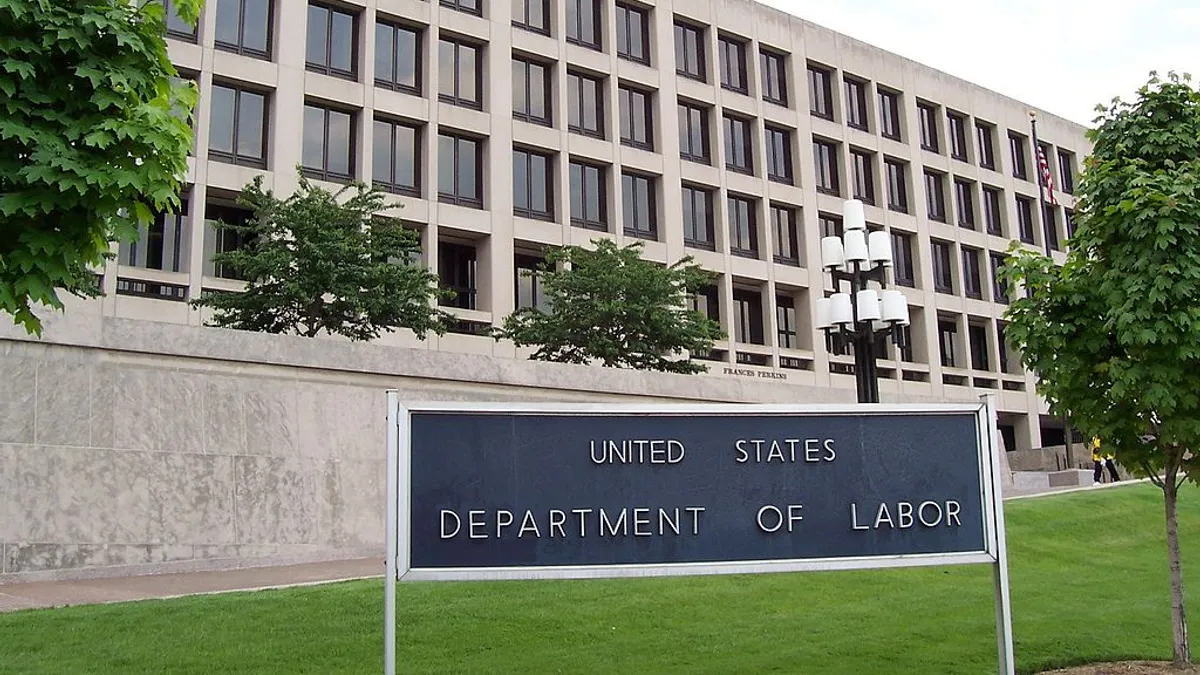Dive Brief:
- The U.S. Department of Labor (DOL) announced today it will publish a final overtime rule, setting the minimum salary threshold for overtime eligibility at $35,568. The regulations implement the Fair Labor Standards Act (FLSA)'s overtime mandate and, according to a senior DOL official, will make an estimated 1.3 million additional U.S. workers eligible for overtime pay. The final rule will be effective Jan. 1.
- The threshold is slightly higher than the $35,308 proposed in the initial draft of the rule and also will allow employers to count non-discretionary bonuses, incentives and commissions as up to 10% of an employee's salary level, as long as those bonuses are paid annually. The FLSA's exemption threshold for highly-compensated employees will be set at $107,432, lower than in DOL's initial draft but still higher than the previous threshold of $100,000.
- A DOL official said Tuesday the agency "has not set out a time frame" for any automatic updates to the overtime eligibility threshold beyond what is included in the final rule. The official also said the final rule released Tuesday will not make changes to the FLSA's "duties test."
Dive Insight:
This is perhaps one of the most anticipated final rulemakings from DOL, and it likely won't be the last before the end of the year. Acting Secretary of Labor Patrick Pizzella told attendees at a recent DOL event to expect several proposed and final rules before the year's end, Bloomberg Law reported.
Pizzella also recognized the possibility of DOL's regs facing lawsuits ahead of implementation, Bloomberg Law said. DOL will likely face legal action of the overtime rule specifically, Tammy McCutchen, shareholder at Littler Mendelson and former wage and hour administrator in the Bush administration, told HR Dive in an earlier interview.
"It's inevitable," McCutchen said, "but that's another reason to get it out as soon as possible."
Some stakeholders took issue with the department's methodology for calculating the new threshold announced in the draft of the rule, which was the same as that used when the threshold was last updated in 2004. That measurement ties the salary level to the 20th percentile of earnings of full-time salaried workers in the retail sector within the lowest-wage census region, the U.S. south.
McCutchen, an author of public comment submitted by the U.S. Chamber of Commerce, said the group objected to this methodology because it included parts of Virginia, Maryland and Washington, D.C., which are also three of the highest wage-earning areas in the U.S. "Because of that, this data should be excluded," McCutchen said. "If they did that, they would end up closer to $32,000 [per year]."
Employee advocates think the new threshold was too low and have spoken out against it for being lower than that proposed by the Obama administration in 2015. Heidi Shierholz, former chief economist at DOL during the Obama administration and current senior economist at progressive think tank Economic Policy Institute, wrote in a blog last week that the DOL's proposal "is a dramatic weakening of a rule published just three years ago." The group estimates more than 8 million workers who would have been eligible for overtime under the enjoined rule would not be under the new rule.
Also at issue was the rule's new minimum threshold for highly-compensated executive employees. McCutchen and others objected to the new, higher threshold for similar methodological reasons, and she noted that small businesses would likely be unable to take advantage of it. Employer groups argued that increases to this threshold should instead be implemented "more gradually over a number of years," McCutchen said.
Employers now have 99 days to comply with the rule.
















